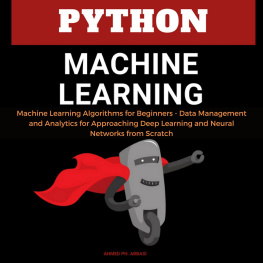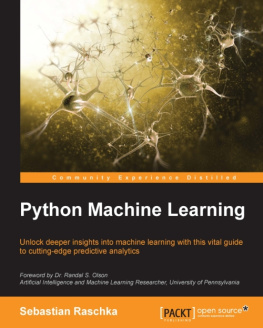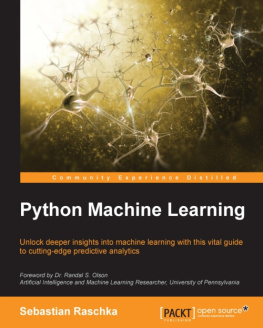Scratch - Python Crash Course: Python Machine Learning. Find out how you can use it for faster coding. Discover algorithms and strategy analysis for finance.
Here you can read online Scratch - Python Crash Course: Python Machine Learning. Find out how you can use it for faster coding. Discover algorithms and strategy analysis for finance. full text of the book (entire story) in english for free. Download pdf and epub, get meaning, cover and reviews about this ebook. year: 2020, genre: Computer. Description of the work, (preface) as well as reviews are available. Best literature library LitArk.com created for fans of good reading and offers a wide selection of genres:
Romance novel
Science fiction
Adventure
Detective
Science
History
Home and family
Prose
Art
Politics
Computer
Non-fiction
Religion
Business
Children
Humor
Choose a favorite category and find really read worthwhile books. Enjoy immersion in the world of imagination, feel the emotions of the characters or learn something new for yourself, make an fascinating discovery.

Python Crash Course: Python Machine Learning. Find out how you can use it for faster coding. Discover algorithms and strategy analysis for finance.: summary, description and annotation
We offer to read an annotation, description, summary or preface (depends on what the author of the book "Python Crash Course: Python Machine Learning. Find out how you can use it for faster coding. Discover algorithms and strategy analysis for finance." wrote himself). If you haven't found the necessary information about the book — write in the comments, we will try to find it.
Scratch: author's other books
Who wrote Python Crash Course: Python Machine Learning. Find out how you can use it for faster coding. Discover algorithms and strategy analysis for finance.? Find out the surname, the name of the author of the book and a list of all author's works by series.
Python Crash Course: Python Machine Learning. Find out how you can use it for faster coding. Discover algorithms and strategy analysis for finance. — read online for free the complete book (whole text) full work
Below is the text of the book, divided by pages. System saving the place of the last page read, allows you to conveniently read the book "Python Crash Course: Python Machine Learning. Find out how you can use it for faster coding. Discover algorithms and strategy analysis for finance." online for free, without having to search again every time where you left off. Put a bookmark, and you can go to the page where you finished reading at any time.
Font size:
Interval:
Bookmark:
- What's your timeframe? (e.g., yearly versus quarterly prices)
- What is your unit of measure? (e.g., USD vs euro)
- What variables must be included? (e.g., only annual salary versus yearly salary and cost of personnel benefits)
- Before you gather new information, determine what data can be gathered from existing sources or databases available. Collect this information.
- Decide on a document saving and naming system beforehand to aid all tasked staff members collaborate. This procedure saves time and prevents staff members out of collecting the identical data twice.
Font size:
Interval:
Bookmark:
Similar books «Python Crash Course: Python Machine Learning. Find out how you can use it for faster coding. Discover algorithms and strategy analysis for finance.»
Look at similar books to Python Crash Course: Python Machine Learning. Find out how you can use it for faster coding. Discover algorithms and strategy analysis for finance.. We have selected literature similar in name and meaning in the hope of providing readers with more options to find new, interesting, not yet read works.
Discussion, reviews of the book Python Crash Course: Python Machine Learning. Find out how you can use it for faster coding. Discover algorithms and strategy analysis for finance. and just readers' own opinions. Leave your comments, write what you think about the work, its meaning or the main characters. Specify what exactly you liked and what you didn't like, and why you think so.



